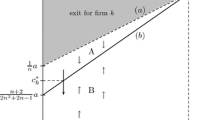Abstract
This paper explores the role of transfer prices as coordinating mechanisms within a firm. Three cases (full information; pure adverse selection; adverse selection and moral hazard) are analyzed and compared to show how quantity and effort are affected as assumptions on observability are progrssively relaxed. The analysis of the second case, having two observable variables, identifies the necessary and sufficient condition under which “the local approach” can be applied. The third case is reinterpreted as transfer prices in a direct delegation setting. The main results are: First, the optimal transfer price is standard average cost plus. Second, it is not necessarily decreasing in quantity unlike the downward sloping demand function.
Similar content being viewed by others
References
Balachandran, K. and J. Ronen, “Incentive Contracts When Production is Subcontracted.” European Journal of Operational Research 40(2), 169–185, (1989).
Banker, R.D. and S.M. Datar, “Optimal Transfer Pricing under Post-Contract Information.” Contemporary Accounting Research 8(2), 329–352, (1992).
Baron, D. and D. Besanko, “Regulation, Asymmetric Information, and Auditing.” RAND Journal of Economics 15(4), 447–470, (1984).
Baron, D. and R.B. Myerson, “Regulating a Monopolist with Unknown Costs.” Econometrica 50(4), 911–930, (1982).
Besanko, D. and D.S. Sibley, “Compensation and Transfer Pricing in a Principal-Agent Model.” International Economic Review 32(1), 55–68, (1991).
Debreu, G., Theory of Value, New Haven: Yale University Press, 1959.
Edlin, A. and S. Reichelstein, “Specific Investment under Negotiated Transfer Pricing: An Efficient Result.” Accounting Review 70, 275–291.
Grabski, S.V., “Transfer Pricing in Complex Organizations: A Review and Integration of Recent Empirical and Analytical Research.” Journal of Accounting Literature 4, 33–75, (1985).
Guesnerie, R. and J.-J. Laffont, “AComplete Solution to a Class of Principal-Agent Problems with an application to the Control of a Self-Managed Firm.” Journal of Public Economics 25(3), 329–369, (1984).
Harris, M., C.H. Kriebel, and A. Raviv, “Asymmetric Information, Incentives and Intrafirm Resource Allocation.” Management Science 28(6), 604–620, (1982).
Harris, M., and A. Raviv, “Optimal Incentive Contracts with Imperfect Information.” Journal of Economic Theory 20(2), 231–259, (1979).
Laffont, J.-J. and J. Tirole, “Using Cost Observation to Regulate Firms.” Journal of Political Economy 94(3), Part 1, 614–641, (1986).
Laffont, J.-J. and D. Martimort, “Collusion under Asymmetric Information.” Econometrica 65(4), 875–911, (1997).
Lewis, T.R. and D.E.M. Sappington, “Countervailing Incentives in Agency Problems.” Journal of Economic Theory 49(2), 294–313, (1989).
Lollivier, S. and J.-C. Rochet, “Bunching and Second Order Conditions: A Note on Optimal Tax Theory.” Journal of Economic Theory 31(2), 392–400, (1983).
Maskin, E.S. and J.G. Riley, “Monopoly with Incomplete Information.” RAND Journal of Economics 15(2), 171–196, (1984).
McAfee, R.P. and J.P. McMillan, “Competition for Agency Contracts.” RAND Journal of Economics 18(2), (1987).
Melumad, N.D. and S. Reichelstein, “Value of Communication in Agencies.” Journal of Economic Theory 47(2), 334–368, (1989).
Mussa, M. and S. Rosen, “Monopoly and Product Quality.” Journal of Economic Theory 18(2), 301–317, (1978).
Myerson, R.B. and M.A. Satterthwaite, “Efficient Mechanisms for Bilateral Trading.” Journal of Economic Theory 29(2), 265–281, (1983).
Picard, P., “On the Design of Incentive Schemes under Moral Hazard and Adverse Selection.” Journal of Public Economics 33, 305–331, (1987).
Ronen, J., “Social Costs and Benefits and the Transfer Pricing Problem.” Journal of Public Economics 3(1), 71–82, (1974).
Ronen, J. and K. Balachandran, “An Approach to Transfer Pricing under Uncertainty.” Journal of Accounting Research 26(2), 300–314, (1988).
Ronen, J. and G. Mckinney, “Transfer Pricing for Divisional Autonomy.” Journal of Accounting Research 8(1), 99–112, (1970).
Seierstad, A. and K. Sydæter, “Sufficient Conditions in Optimal Control Theory.” International Economic Review 18(2), 367–391, (1977).
Vaysman, I., “A Model of Cost-based Transfer Pricing.” Review of Accounting Studies 1, 73–108.
Villadson, B., “Communication and Delegation in Collusive Agencies.” Journal of Accounting and Economics 19, 315–344.
Wagenhofer, A., “Transfer Pricing under Asymmetric Information: An Evaluation of Alternative Methods.” European Accounting Review 1, 71–104.
Author information
Authors and Affiliations
Rights and permissions
About this article
Cite this article
Yeom, S., Balachandran, K.R. The Role of Transfer Price for Coordination and Control within a Firm. Review of Quantitative Finance and Accounting 14, 161–192 (2000). https://doi.org/10.1023/A:1008355713528
Issue Date:
DOI: https://doi.org/10.1023/A:1008355713528




